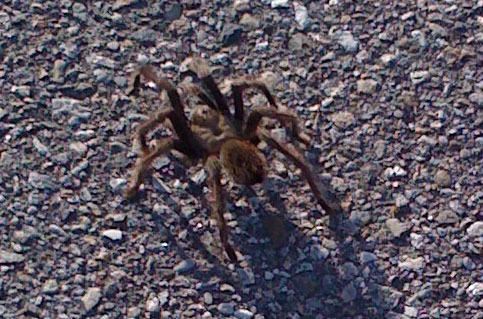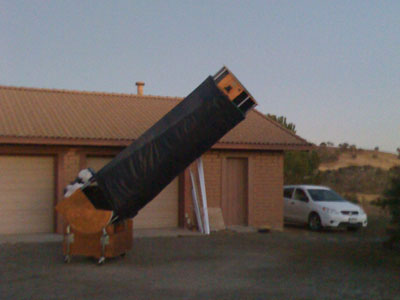I had originally planned to go to the DARC observatory on Saturday night. However, due to a dismal weather forecast, I was forced to rethink my plans. The forecast for Friday night was actually looking pretty good, and an opportunity came up to go to Willow Springs. I had never been up there before, so I jumped at the opportunity, packed my gear in a hurry, and headed down to Deep Sky Ranch.
While driving on Little Panoche Rd, something interesting caught my eye: a tarantula was slowly crossing the roadway. On the way back this morning, I pulled over to take this photograph:

Willow Springs is a great place for deep sky visual observing. The sky is fairly dark, and the only really noticeable light dome, emanating from Hollister, is not much of a problem. Here is a summary of last night’s weather conditions:
- No wind.
- Temperatures in the low 50s.
- Average seeing.
- Average transparency.
- Very high humidity: my table top and paper charts were soaked, and my eyepieces were covered in dew.
Were present Steve Gottlieb, Mark Wagner, Mark Johnston, Rogelio Bernal Andreo, Richard Navarette and of course our gracious host, Kevin Ritschel. Here is a photo of famous DobZilla, Kevin’s 30″ dobsonian telescope:

Since I am almost done with the Herschel 400 list, I had decided to start a new project: observing the galaxy groups featured in one of Alvin Huey’s free downloadable observing guides: Selected Small Galaxy Groups. These galaxy groups are fascinating because they are a real test of the observer’s visual acuity and equipment. Although the brightest members are usually immediately detected, these groups reward patient observers. The more time is spent at the eyepiece, the greater the number of galaxies that become visible! This way, I was able to detect a good number of members after spending about 30 minutes on a given group. I did not take detailed notes of my observations this time around, but I did write down the list of members I was positively able to detect. All observations were done using my Meade Lightbridge 12″ F/5 dobsonian telescope, and using mostly my 9mm Televue Nagler type 6.
NGC 383 Group (also known as the Pisces Group)
NGC 373/NGC 375/NGC 379/NGC 380/NGC 382/NGC 383/NGC 384/NGC 385/NGC 386/NGC 387 (hard!)/NGC 388
NGC 3 Group (Pisces)
NGC 3/NGC 4 (hard!)/NGC 7837/NGC 7838
NGC 507 Group (Pisces)
NGC 494/NGC 495/NGC 496/NGC 499/NGC 501/NGC 503/NGC 504/NGC 507/NGC 508/NGC 515/NGC 517/IC 1682/IC 1687/IC 1689/IC 1690
NGC 80 Group (Andromeda) - Featured in the current edition of S&T’s “Going Deep” column.
NGC 79/NGC 80/NGC 81 (hard!)/NGC 83/MGC 4-2-10 (PGC 1384, and also sometimes incorrectly labeled NGC 84) (hard!)/NGC 85/NGC 86/NGC 90/NGC 93/NGC 94/NGC 96
I also observed this group through Mark Johnston 18″ scope, and confirmed seeing some of the dimmest members.
Perseus Cluster
NGC 1129/NGC 1130/NGC 1131/IC 265/MCG 7-7-3 (PGC 10953)/MCG 7-7-8 (PGC 10980)
Big thanks to Kevin Ritschel for hosting this star party and for sharing stunning views through DobZilla. Also, big thanks to Alvin Huey for putting together the observing guides and making them freely downloadable on his web site.